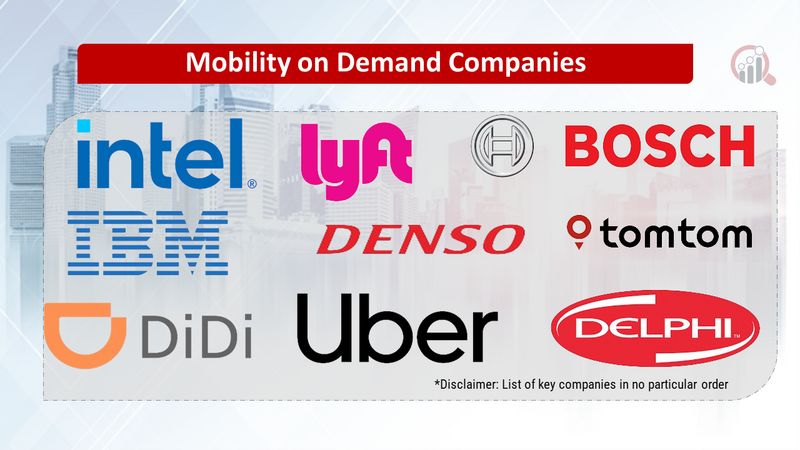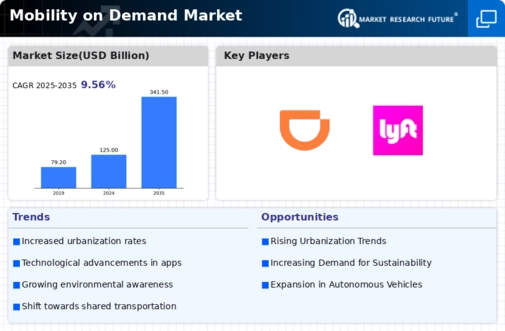Top Industry Leaders in the Mobility Demand Market

Mobility on Demand Market: Dive into the Latest News and Updates
In today's fast-paced world, getting around the city has become less about car ownership and more about instant access to diverse transportation options. The Mobility on Demand (MoD) Market thrives on this dynamic landscape, connecting riders with a variety of transportation services through convenient digital platforms.
Some of Mobility on Demand Companies Listed Below:
- Delphi Automotive Plc (UK)
- International Business Machines Corp. (US)
- Tomtom NV (Netherlands)
- Lyft (US)
- DidiChuxing (China)
- Uber Technologies Inc. (US)
- Denso Corporation (Japan)
- Robert Bosch Gmbh (Germany)
- Intel Corporation (US)
- Gett Inc. (US)
Strategies Propelling Market Growth:
- Focus on Multimodal and Integrated Platforms: Offering diverse transportation options like ride-hailing, micromobility, and public transit integration increases user convenience and attracts a wider customer base.
- Subscription and Loyalty Programs: Introducing subscription models and loyalty programs encourages regular usage and fosters customer retention.
- Data-Driven Operations and Dynamic Pricing: Utilizing data analytics to optimize service availability, predict demand, and adjust pricing dynamically ensures efficient operations and cost-effectiveness.
- Partnerships and Collaboration: Collaborating with public transportation authorities, other MoD providers, and local businesses expands reach and enhances service offerings.
Market Share Decoding: Key factors to Consider:
- Geographical Reach and Service Coverage: Companies operating in multiple cities and offering diverse transportation options attract broader customer bases.
- User Interface and Convenience: Intuitive app design, booking procedures, and seamless integration with various modes of transport enhance user experience and drive adoption.
- Pricing and Affordability: Competitive pricing models and cost-effective options for specific use cases (e.g., short trips, shared rides) cater to diverse budgets and travel needs.
- Safety and Security Features: Robust safety measures, data privacy policies, and reliable customer support build trust and attract risk-averse users.
New and Emerging Stars: Illuminating the MoD Path:
- Connected and Autonomous Vehicles (CAVs): Startups like Pony.ai and Waymo are pioneering autonomous ride-hailing services, offering future-proof MoD solutions with the potential to revolutionize urban transportation.
- Urban Air Mobility (UAM): Companies like Joby Aviation and Volocopter are developing electric vertical take-off and landing (eVTOL) vehicles for on-demand air travel, opening up new dimensions in MoD.
- Demand-Responsive Public Transportation: Public transportation systems utilizing AI and big data to dynamically adjust routes and schedules based on real-time demand offer efficient and user-centric mobility solutions.
Investment Trends: Where the MoD Dollars Flow:
- Multimodal and Integrated MoD Platforms: Investors are backing companies developing platforms that seamlessly integrate various MoD options, catering to the growing demand for multimodal travel.
- Electrification and Micromobility Solutions: Investments are pouring into companies offering e-bikes, scooters, and electric ride-hailing options, aligning with sustainability goals and promoting eco-friendly urban mobility.
- Connected and Autonomous Vehicles (CAVs): The potential of CAVs for revolutionizing the transportation landscape attracts significant investment in developing and deploying these future-proof MoD solutions.
Latest Company Updates:
February 7, 2024:
- Integration of MoD platforms with city planning and traffic management systems: Optimizing traffic flow and prioritizing sustainable transportation options.
- Focus on multimodal transportation and seamless interconnectivity: Combining different MoD services like bike-sharing, car-sharing, and public transit for enhanced user experience.
February 14, 2024:
- Rise of subscription models and personalized MoD packages: Tailoring services to individual needs and preferences for flexibility and affordability.
- Focus on data-driven insights and dynamic pricing: Utilizing user data to adjust service availability and pricing based on real-time demand and supply.
March 7, 2024:
- Growing adoption of electric vehicles (EVs) and charging infrastructure for sustainable MoD: Reducing emission footprint and promoting clean transportation solutions.
- Focus on micro-mobility options like e-scooters and e-bikes: Providing first-mile/last-mile connectivity and reducing car dependency in urban areas.

